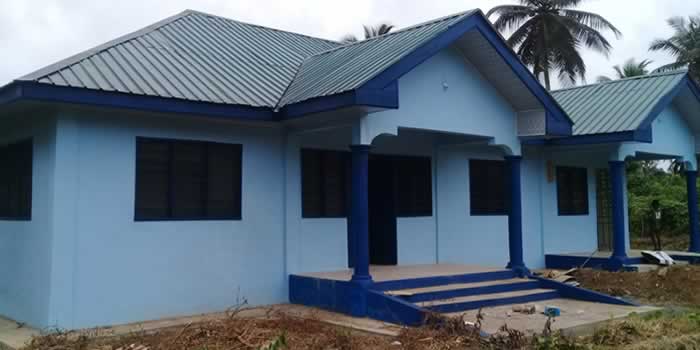

Population
The population of the district is 111,348 with a density of 83 persons per km2 and an annual growth rate of 3%. (2000 PHC Census).
Major Settlements
Half Assini, Bonyere-Ezinlibo, Elubo, tikobo No. 1, Beyin, Tikobo No. 2, Elloin-Kengen, Takinta, Jaway Wharf and Samenye.
The demographic structure of Jomoro Municipal has some common features with other rural districts in Ghana like low density, high mortality rates and relatively high out migration. However, there are some specific characteristics due to the low development level of the district. Refer to table 5 in pdf file below.
From the table above, the population of the district fell from 45, 162 in 1960 to 37,685 in 1970. It sharply rose to 70,881 in 1984 and that of the year 2000 was 111,348. The population density of 83 persons per square kilometer in 2000 portrays a rural district where population is not yet a problem.
The fall in population recorded in the district for 1970 may be due to out-migration sparked off by a combination of the following factors;
- Falling price of copra, which led many farmers to move out of the District to other parts of the Region in search o land to cultivate cocoa.
- The operations of the border guards along the border made smuggling dangerous and not lucrative and thus encouraged migration of many people, (most of whom were goldsmiths) from the district to the Ivory Coast and the mining areas of the country.
- Poor accessibility to many parts of the district, especially in the Northern part, contributed to migration of young traders and others engaged in commercial activities to move out of the area to other parts of the country where prospects were brighter.
The sudden rise of population in 1984 to present day may be due to the stability in the price of copra on the local market, which did not act as push factor for massive out-migration.
Closely related to the above is the completion of the highway linking La Cote d’Ivoire between the late 1980’s and early 1990’s coupled with increased commercial activities at the local market. This generated a rapid wave of in-migration from other parts of the country and even other West African Countries to the district.
Age/Sex Distribution
The male population of the district constitutes 49.7% while the female takes 50.3%. This shows a deviation from the Regional figure that indicates higher percentage for males than females. The population of the district is 5.8% of that of the region. The dependency ratio is approximately 1:1. The male population of Jomoro constitutes 49.7% while that of female takes 50.3%.
Deducted from the table, the pattern of male population to female population is not different from that of the national pattern. The 0-14 cohorts constitute 67 percent of the total population while the aged 65 years and above make only 2 percent. The dependant population in the district, that is those in cohorts 0-14 years plus those in cohorts 65 years and above constitutes 69% of the total population.
The economically active population (i.e. 15-64 years cohort) constitutes 31 percent of the total population. The dependency ratio in the district, that is the ratio of the elderly (those aged 65 years and above) plus the youth (those under 15 years) to the population in the “working age” (those in cohorts 15-64 years of age) is 0.278:1. This in demographic sense means that, every 100 economically active persons have 278 extra persons to cater for. Simply stated, the ratio is 1:3 implying that every 1 person feeds 3 extra people in the district.
Implications of Age/Sex Composition and Population
Pyramid for Planning Purposes
The district population is a youthful one. This is a necessary potential when the youth are able to acquire the requisite skills and education so that they can shape a better future for themselves as well as their kinsmen in the district. On the other hand, it is possible that family planning issues have not caught up well with people in the district hence there is a need to marshall available resource to bring the situation under control.
The labour force of 31 percent of the total population can be analyzed from past dwindling economic fortunes that befell the district. More so, as an agrarian district with 70 percent of the population being rural, economic opportunities are few. This has indeed compelled many of the labour force to embark on out migration to Takoradi, Tarkwa and La Côte D’ Ivoire to seek for greener pastures.
Spatial Analysis
The district space economy is understood by analyzing the existing settlement patterns and the spatial linkages. This provides an insight into the functions performed by settlements and their hierarchy which the centrality indices are used to assess.
The population distribution by settlement is as shown in figure…………….
Some of the relatively larger settlements with population threshold of 350 plus was used to develope a scalogram as shown in figure……….. A scalogram is a matrix presentation of the functional structure of settlements. These settlements provide essential services to themselves and their respective trajectory areas.
Location And Distribution Of Services
This deals with the type of number and distribution of facilities and services within the district. It also aims at assessing the adequacy of these facilities and services and identifies the disadvantaged areas. A critical look at the map showing the distribution of services, figure………..shows that most of the services are of lower order and as such the settlement spheres of influence are limited to their immediate surroundings.
Scalogram Analysis
The hierarchy of settlements has been determined by reference to the districts population size and the functional classification and centrality of settlements based on types of services available. The functions and settlements were ordered in their rank of importance starting with the most abundant function and the settlement, which has the most facilities.
The next step was to compute the centrality index for each function. This was done by dividing a score of 100 by the number of times this function is actually present in the district e.g. widely available function like traditional healer earns a low score while scarce function like hospital earns a high score of 100. The centrality score for each settlement was then summed up.
Based on the summation, the settlements were then put into categories (orders) of levels 1, 2, 3 and 4. level 1, are those with total functions of 65 percent and above, level 2 are those with 50 percent of total functions, level 3 are those with 40-49 percent and level 4 are those below 40 percent of total functions or services.
The analysis revealed that majority of the settlements lack most of the basic functions such as potable water, electricity and health facilities and had to depend on other settlements. Half Assini and Elubo occupy level 1 position with Tikobo No. 1 and Bonyere occupying level 2 position. Level 3 position, is taken by Jewi Wharf and Tikobo No. 2 thus more than two-thirds of settlements in the system occupy the fourth position showing the unbalanced distribution of the central functions and services.
Levels of Spatial Development
A further analysis based on the scalogram, identified five steps/levels of development around Half Assini, Elubo, Tikobo No.1 & 2 and Bonyere with Half Assini and Elubo occupying level 1.
This shows a disintegrated spatial development as the district shows pockets of moderately developed few areas surrounded by a vast number of deprived areas. A concerted effort from the Assembly and the local communities is therefore necessary to upgrade some settlements.
Date Created : 11/20/2017 4:27:19 AM









 facebook
facebook
 twitter
twitter
 Youtube
Youtube
 +233 593 831 280
+233 593 831 280 0800 430 430
0800 430 430 GPS: GE-231-4383
GPS: GE-231-4383 info@ghanadistricts.com
info@ghanadistricts.com Box GP1044, Accra, Ghana
Box GP1044, Accra, Ghana